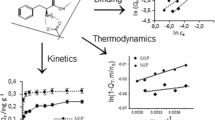Abstract
A D-Phenylalanine (Phe) imprinted terpolymer, Polyacrylonitrile-Poly(acrylic acid)-Poly(acryl amide) (Poly(AN-AA-AAm)) bead was prepared by the wet-phase inversion method. Acrylamide (AAm) and acrylic acid (AA) were used as the functional monomer and acrylonitrile (AN) was used as a physical cross linker. The characteristics of selective adsorption by the D-Phe imprinted terpolymer beads were investigated at high concentrations of Phe racemate solution, 1 g Phe/L, and 10 g Phe/L. The adsorption selectivity of the D-Phe imprinted terpolymer beads prepared by anin-situ implanting method reached 0.82 and 0.8 at 1.0 g and 10 g Phe/L racemate solution, respectively, and almost all of the adsorbed D-Phe and about 43% of the adsorbed L-Phe were desorbed by 4% acetic acid. The uptake capacities of the terpolymer beads were maintained for several repeated batches.
Similar content being viewed by others
References
Chen, Y., Kele, M., Quinones, I., Sellergren, B. and Guiochon, G., “Influence of the pH on the Behavior of an Imprinted Polymeric Stationary Phase Supporting Evidence for a Binding Site Model,”J. Chromatogr. A,927, 1 (2001).
Jin, J. S.,Preparation of HPLC Chiral Stationary Phase and Resolution ofEnantiomers, PhD Thesis, Pusan National University, Korea (1999).
Klein, J. U., Whitecombe, M. J., Mulholland, F. and Vulfson, E. N., “Template-mediated Synthesis of a Polymeric Receptor Specific to Amino Acid Sequences,”Angew. Chem. Int. Ed. Engl.,38, 2057 (1997).
Mosbach, K. and Haupt, K., “Some New Developments and Challenges in Noncovalent Molecular Imprinting Technology,”J. Molecul. Recogn.,11, 62 (1998).
Park, J. K. and Seo, J. I., “Characteristics of Phenylalanine Imprinted Membrane Prepared by the Wet Phase Inversion Method,”Korean J. Chem. Eng.,19, 940 (2002).
Park, J. K., Kim, S. J. and Lee, J. W., “Adsorption Selectivity of Phenylalanine Imprinted Polymer Prepared by the Wet Phase Inversion Method,”Korean J. Chem. Eng.,20, 1066 (2003).
Park, J. K., Khan, H. and Lee, J. W., “Preparation of Phenylalanine Imprinted Polymer by Sol-gel Transition Method,”Enzyme and Microbial Tech.,35, 688 (2004).
Park, J. K. and Kim, S. J., “Separation of Phenylalanine by Ultrafiltration Using D-Phe Imprinted Polyacrylonitrile-Poly(acrylic acid)-Poly(acryl amide) Terpolymer Membrane,”Korean J. Chem. Eng. 21, 994 (2004).
Ramstrom, O., Ye, L., Krook, M. and Mosbach, K., “Applications of Molecularly Imprinted Materials as Selective Adsorbents: Emphasis on Enzymatic Equilibrium Shifting and Library Screening,”Chromatographia,47, 465 (1998).
Takagishi, T. and Klotz, I. M., “Macromolecule Small Interactions; Introduction of Additional Binding Sites in Polyethyleneimine by Disulfide Cross-Linkages,”Biopolymers,11, 483 (1972).
Wang, H. Y., Kobayashi, T., Fukaya, T. and Fujii, N., “Molecular Imprint Membranes Prepared by the Phase Inversion Technique. 2. Influence of Coagulation Temperature in the Phase Inversion Process on the Encoding in Polymeric Membranes,”Langmuir.,13, 5396 (1997).
Wulff, G. and Sarhan, A., “über die Anwendung von Enzymanalog Gebauten Polymeren zur Racemattrennung,”Angew. Chem.,84, 364 (1972).
Wulff, G.,Molecular Interactions in Bioseparations, edited by That T. Ngo., Plenum Press, New York, 363 (1993).
Yoshikawa, M., Fujisawa, T., Izumi, J., Kitao, T. and Sakamoto, S., “Molecularly Imprinted Polymeric Membranes Involving Tetrapeptide EQKL Derivatives as Chiral-recognition Sites toward Amino Acids,”Anal. Chim. Acta,365, 59 (1998).
Yu, C. and Mosbach, K., “Molecular Imprinting Utilizing an Amide Functional Group for Hydrogen Bonding Leading to Highly Efficient Polymers,”J. Org. Chem.,62, 4057 (1997).
Zhou, J., He, X. and Li, Y., “Binding Study on 5,5-Diphenylhydantion Imprinted Polymer Constructed by Utilizing an Amide FunctionalGroup,” Anal. Chim. Acta,394, 353 (1999).
Author information
Authors and Affiliations
Corresponding author
Rights and permissions
About this article
Cite this article
Park, J.K., Lee, J.W. Characteristics of selective adsorption using D-phenylalanine imprinted terpolymer beads. Korean J. Chem. Eng. 22, 927–931 (2005). https://doi.org/10.1007/BF02705677
Received:
Accepted:
Issue Date:
DOI: https://doi.org/10.1007/BF02705677



